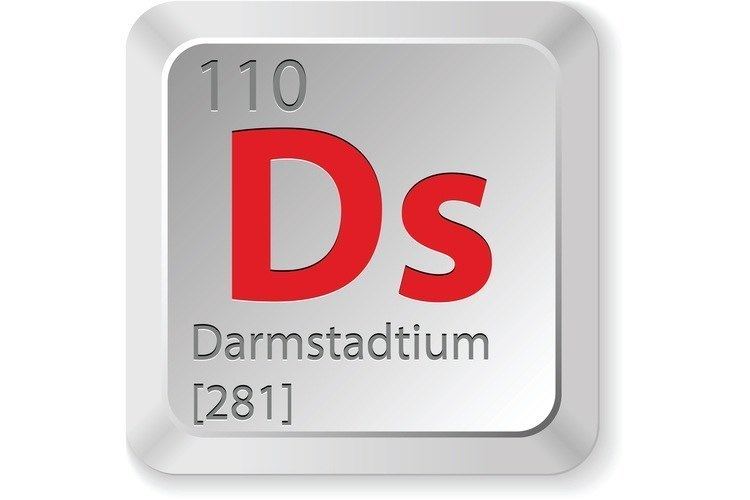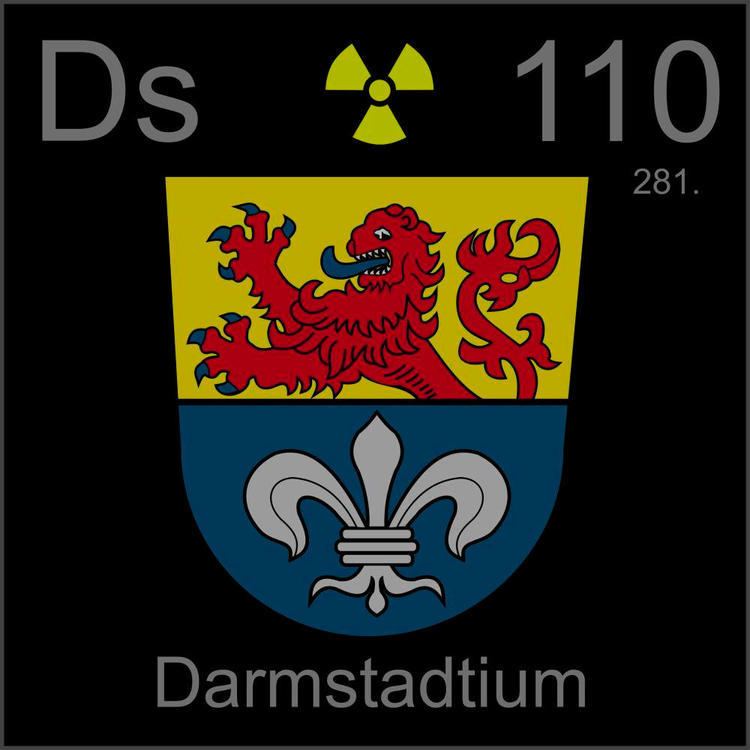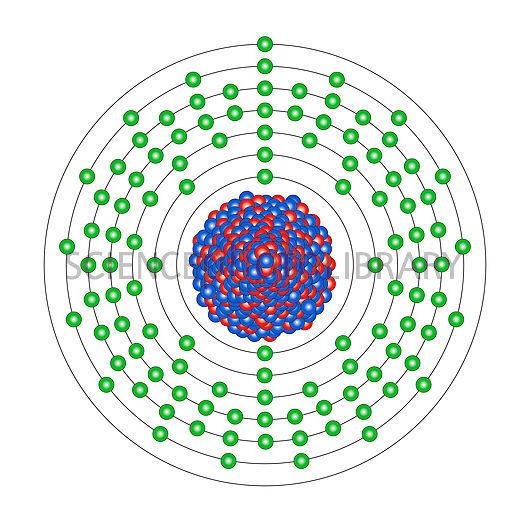Name, symbol darmstadtium, Ds Standard atomic weight (Ar) [281] Atomic mass 281 u Discovered 1994 | Group, block group 10, d-block Symbol Ds Atomic number 110 CAS ID 54083-77-1 | |
 | ||
Pronunciation /dɑːrmˈʃtɑːtiəm/darm-SHTAHT-ee-əm Element category unknown, but probably a transition metal Electron configuration [Rn] 5f 6d 7s(predicted) | ||
Darmstadtium periodic table of videos
Darmstadtium is a chemical element with symbol Ds and atomic number 110. It is an extremely radioactive synthetic element. The most stable known isotope, darmstadtium-281, has a half-life of approximately 10 seconds. Darmstadtium was first created in 1994 by the GSI Helmholtz Centre for Heavy Ion Research near the city of Darmstadt, Germany, after which it was named.
Contents
- Darmstadtium periodic table of videos
- Darmstadtium version 1 periodic table of videos
- Discovery
- Naming
- Isotopes
- Stability and half lives
- Chemical
- Physical and atomic
- Experimental chemistry
- References

In the periodic table, it is a d-block transactinide element. It is a member of the 7th period and is placed in the group 10 elements, although no chemical experiments have yet been carried out to confirm that it behaves as the heavier homologue to platinum in group 10 as the eighth member of the 6d series of transition metals. Darmstadtium is calculated to have similar properties to its lighter homologues, nickel, palladium, and platinum.

Darmstadtium version 1 periodic table of videos
Discovery

Darmstadtium was first created on November 9, 1994, at the Institute for Heavy Ion Research (Gesellschaft für Schwerionenforschung, GSI) in Darmstadt, Germany, by Peter Armbruster and Gottfried Münzenberg, under the direction of Sigurd Hofmann. The team bombarded a lead-208 target with accelerated nuclei of nickel-62 in a heavy ion accelerator and detected a single atom of the isotope darmstadtium-269:
20882Pb + 62
28Ni → 269
110Ds + 1
0n

In the same series of experiments, the same team also carried out the reaction using heavier nickel-64 ions. During two runs, 9 atoms of 271Ds were convincingly detected by correlation with known daughter decay properties:
20882Pb + 64
28Ni → 271
110Ds + 1
0n

Prior to this, there had been failed synthesis attempts in 1986–7 at the Joint Institute for Nuclear Research in Dubna (then in the Soviet Union) and in 1990 at the GSI. The IUPAC/IUPAP Joint Working Party (JWP) recognised the GSI team as discoverers in their 2001 report.
Naming
Using Mendeleev's nomenclature for unnamed and undiscovered elements, darmstadtium should be known as eka-platinum. In 1979, IUPAC published recommendations according to which the element was to be called ununnilium (with the corresponding symbol of Uun), a systematic element name as a placeholder, until the element was discovered (and the discovery then confirmed) and a permanent name was decided on. Although widely used in the chemical community on all levels, from chemistry classrooms to advanced textbooks, the recommendations were mostly ignored among scientists in the field, who called it "element 110", with the symbol of (110) or even simply 110.
In 1996, the Russian team proposed the name becquerelium after Henri Becquerel. The American team in 1997 proposed the name hahnium after Otto Hahn (previously this name had been used for element 105).
The name darmstadtium (Ds) was suggested by the GSI team in honor of the city of Darmstadt, where the element was discovered. The GSI team originally also considered naming the element wixhausium, after the suburb of Darmstadt known as Wixhausen where the element was discovered, but eventually decided on darmstadtium. The new name was officially recommended by IUPAC on August 16, 2003.
Isotopes
For a detailed list of information on the discovery of each individual darmstadtium isotope, see isotopes of darmstadtium.Darmstadtium has no stable or naturally occurring isotopes. Several radioactive isotopes have been synthesized in the laboratory, either by fusing two atoms or by observing the decay of heavier elements. Nine different isotopes of darmstadtium have been reported with atomic masses 267, 269–271, 273, 277, and 279–281, although darmstadtium-267 and darmstadtium-280 are unconfirmed. Two darmstadtium isotopes, darmstadtium-270 and darmstadtium-271, have known metastable states. Most of these decay predominantly through alpha decay, but some undergo spontaneous fission.
Stability and half-lives
All darmstadtium isotopes are extremely unstable and radioactive; in general, the heavier isotopes are more stable than the lighter. The most stable known darmstadtium isotope, 281Ds, is also the heaviest known darmstadtium isotope; it has a half-life of 11 seconds. The isotope 279Ds has a half-life of 0.18 seconds respectively. The remaining six isotopes and two metastable states have half-lives between 1 microsecond and 70 milliseconds. Some unknown isotopes in this region, such as 272Ds and 274–276Ds, are predicted to also have rather long half-lives of a few seconds. Before its discovery, 277Ds was predicted to have a half-life of around 5 seconds, but it has since been found to have a half-life of only 5.7 milliseconds. Likewise, while 280Ds was originally predicted to have a half-life of about 11 seconds, more recent work that may have detected it as the electron-capture daughter of 280Rg, have found for it a half-life of much less than a second.
The undiscovered isotope 284Ds has been predicted to be the most stable towards beta decay; however, no known darmstadtium isotope has been observed to undergo beta decay. Theoretical calculation in a quantum tunneling model reproduces the experimental alpha decay half-life data for the known darmstadtium isotopes. It also predicts that the undiscovered isotope 294Ds, which has a magic number of neutrons (184), would have an alpha decay half-life on the order of 311 years: exactly the same approach predicts a ~3500-year alpha half-life for the non-magic 293Ds isotope, however.
Chemical
Darmstadtium is the eighth member of the 6d series of transition metals. Since copernicium (element 112) has been shown to be a transition metal, it is expected that all the elements from 104 to 112 would form a fourth transition metal series, with darmstadtium as part of the platinum group metals and a noble metal. Calculations on its ionization potentials and atomic and ionic radii are similar to that of its lighter homologue platinum, thus implying that darmstadtium's basic properties will resemble those of the other group 10 elements, nickel, palladium, and platinum.
Prediction of the probable chemical properties of darmstadtium has not received much attention recently. Darmstadtium is expected to be a noble metal. Based on the most stable oxidation states of the lighter group 10 elements, the most stable oxidation states of darmstadtium are predicted to be the +6, +4, and +2 states; however, the neutral state is predicted to be the most stable in aqueous solutions. In comparison, only palladium and platinum are known to show the maximum oxidation state in the group, +6, while the most stable states are +4 and +2 for both nickel and palladium. It is further expected that the maximum oxidation states of elements from bohrium (element 107) to darmstadtium (element 110) may be stable in the gas phase but not in aqueous solution. Darmstadtium hexafluoride (DsF6) is predicted to have very similar properties to its lighter homologue platinum hexafluoride (PtF6), having very similar electronic structures and ionization potentials. It is also expected to have the same octahedral molecular geometry as PtF6. Other predicted darmstadtium compounds are darmstadtium carbide (DsC) and darmstadtium tetrachloride (DsCl4), both of which are expected to behave like their lighter homologues.
Physical and atomic
Darmstadtium is expected to be a solid under normal conditions and to crystallize in the body-centered cubic structure, unlike its lighter congeners which crystallize in the face-centered cubic structure, because it is expected to have different electron charge densities from them. It should be a very heavy metal with a density of around 34.8 g/cm3. In comparison, the densest known element that has had its density measured, osmium, has a density of only 22.61 g/cm3. This results from darmstadtium's high atomic weight, the lanthanide and actinide contractions, and relativistic effects, although production of enough darmstadtium to measure this quantity would be impractical, and the sample would quickly decay.
The outer electron configuration of darmstadtium is calculated to be 6d87s2, which obeys the Aufbau principle and does not follow platinum's outer electron configuration of 5d96s1. This is due to the relativistic stabilization of the 7s2 electron pair over the whole seventh period, so that none of the elements from 104 to 112 are expected to have electron configurations violating the Aufbau principle. The atomic radius of darmstadtium is expected to be around 132 pm.
Experimental chemistry
Unambiguous determination of the chemical characteristics of darmstadtium has yet to have been established due to the short half-lives of darmstadtium isotopes and a limited number of likely volatile compounds that could be studied on a very small scale. One of the few darmstadtium compounds that are likely to be sufficiently volatile is darmstadtium hexafluoride (DsF
6), as its lighter homologue platinum hexafluoride (PtF
6) is volatile above 60 °C and therefore the analogous compound of darmstadtium might also be sufficiently volatile; a volatile octafluoride (DsF
8) might also be possible. For chemical studies to be carried out on a transactinide, at least four atoms must be produced, the half-life of the isotope used must be at least 1 second, and the rate of production must be at least one atom per week. Even though the half-life of 281Ds, the most stable confirmed darmstadtium isotope, is 11 seconds, long enough to perform chemical studies, another obstacle is the need to increase the rate of production of darmstadtium isotopes and allow experiments to carry on for weeks or months so that statistically significant results can be obtained. Separation and detection must be carried out continuously to separate out the darmstadtium isotopes and automated systems can then experiment on the gas-phase and solution chemistry of darmstadtium as the yields for heavier elements are predicted to be smaller than those for lighter elements; some of the separation techniques used for bohrium and hassium could be reused. However, the experimental chemistry of darmstadtium has not received as much attention as that of the heavier elements from copernicium to livermorium.
The more neutron-rich darmstadtium isotopes are the most stable and are thus more promising for chemical studies; however, they can only be produced indirectly from the alpha decay of heavier elements, and indirect synthesis methods are not favourable for chemical studies. The more neutron-rich isotopes 276Ds and 277Ds might be produced directly in the reaction between thorium-232 and calcium-48, but the yield is expected to be low. Furthermore, this reaction has already been tested without success, and more recent experiments that have successfully synthesized 277Ds using indirect methods show that it has a short half-life of 5.7 ms, not long enough to perform chemical studies.
